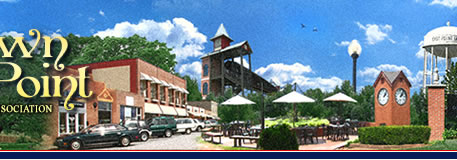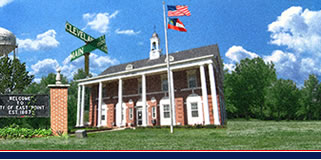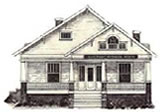


East Point Main Street Association, Inc. – PO Box 91274, East Point, GA 30344 |
 |
East Point, communicating a sense of place, community pride and heritage, while providing for a successful business and
residential environment.
Downtown Flashback Feature
Each month, EPMSA will dig through the East Point Historical Society's archives to provide you with that month's "Flashback Feature". Each feature will highlight a photo and/or article from East Point's vibrant history. The photos/articles will give you a brief look at East Point back then . . . more information about East Point's history is available at the East Point Historical Society located at 1685 Norman Berry Drive, East Point, GA 30344. You can contact them at (404) 767-4656 or visit www.eastpoinths.org. All "Flashback Features" will be archived on the website and can be accessed at any time.
East Point: 125 Years Ago, Part One

2747 Main Street, the former location of the East Point Post Office.
This building once served as a vital component for mail services for the community
and is now an iconic piece of the historic fabric of Downtown East Point
and serves as the home of Bryson Contructors.
This summer, the City of East Point celebrates the 125th anniversary of its incorporation, chartered on August 3, 1887, by the General Assembly and signed by the Governor on August 10.
Here begins a 3-part series of highlights from East Point’s history leading up to 1887.
In the 1821 Treaty of Indian Springs, land that now includes East Point was purchased for $200,000 from the Creek Indians.
Later that same year in the land lottery, 48 Georgians were awarded the lots that make up East Point. Most of these original landowners sold their property to those who would soon settle in East Point.
The town of East Point was the result of a strategic location where in 1847 the Atlanta and West Point and Central of Georgia Railroads intersected. East Point was the eastern terminus of the A&WP that ran on to LaGrange. The Central of Georgia ran to Macon.
The Newnan Road was the only road leading west out of Atlanta toward East Point. Unlike current Main Street, it did not always parallel the railroad tracks but meandered along what is now Newnan, Church and Semmes Streets and then to present-day Washington Road toward Red Oak. A dirt road, it was often impassable until the 1890s when it was “cherted” with limestone.
By 1864, there were four grist mills, three cotton gins, four churches, and one distillery. Owned by the U.S. government, the distillery was probably near the Conley Mill in the vicinity of what is now Semmes Street and Montrose Drive. Its operations required one of the earliest local industries, the East Point Jug Factory. The distillery burned in 1876 and was never rebuilt.
East Point was part of a network of fortifications that encircled Atlanta during the Civil War. These defense lines spread from present day Jefferson Park to Tri-Cities High School to City Hall to Delowe Drive. Union forces broke through defenses around East Point and to the south, destroyed the railroads and broke the vital supply routes into Atlanta. Atlanta fell on September 2, 1864. Many of East Point’s buildings and houses were destroyed during the Union army occupation.
Shady Grove Methodist Church was first organized at the Connally Plantation, probably East Point’s best known antebellum plantation. After the Civil War, the congregation built at the corner of West Forrest and Church Streets. In recent years, the long-time congregation there merged with a long-time and nearby African American church and became the First Mallalieu United Methodist Church.
Just north of this site was East Point’s oldest African American congregation, Union Baptist Church formed in 1866 and, like most African American churches, home to a school for its members. In 1884, a simple but elegant Gothic-style building was erected on what is now South Fulton Hospital.
Sixteen families were major landowners in the early years. Some of their names are given to local landmarks and streets: Lester, Thompson, Taylor, Ware, Redwine, Lyle and Harris.
Enslaved individuals at the Connally Plantation were the earliest known African Americans living in East Point during
its early years; Wilkes, Ed and Jenny are buried at the Connally Plantation cemetery near Hamilton Holmes Elementary
School. Other African Americans living in East Point after emancipation whose names and contributions are remembered
are Jennie Armstrong, Frank Tidwell and Moses Rambo.
-Carole Griffith

Be sure to visit the East Point Historical Society at 1685
Norman Berry Drive to learn more about our city’s history. Museum & Archives - Free Admission
-
Thursdays 1 - 4 p.m., Saturdays 11 a.m. - 3 p.m.
- Phone: 404-767-4656